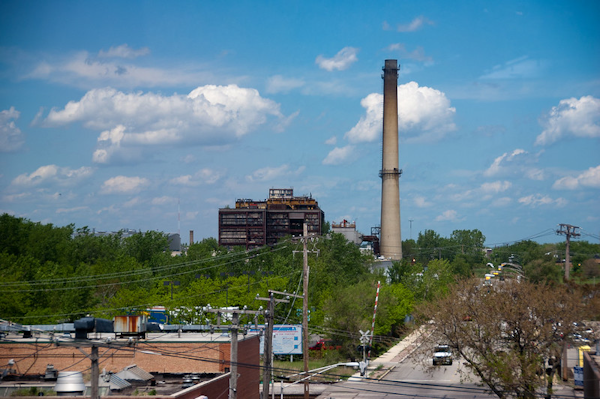SEJournal Online is the digital news magazine of the Society of Environmental Journalists. Learn more about SEJournal Online, including submission, subscription and advertising information.
 |
 |
| As many as 70 municipal waste incinerators, supposed to close over the years, are still operating. Above, Chicago’s old Northwest Incinerator, decommissioned in 1996. Photo: Eric Allix Rogers via Flicklr Creative Commons (CC BY-NC-ND 2.0). |
TipSheet: Waste Incineration May Put Toxics Into Local Air
By Joseph A. Davis
 |
Waste incineration is an environmental problem that some cities hope is out of sight and out of mind. Wait, you say: Isn’t waste incineration on the way out? Not really. Not everywhere. Not enough. In much of the world, it is actually increasing.
In the United States, the number of legally permitted waste incinerators was supposed to go down over the past several decades, as individual incinerators were progressively closed.
But many facilities are still operating as the industry merely changes its stripes. There are still some 70 legal municipal waste incinerators. Plus more industrial incinerators, medical waste incinerators and incinerators relabeled as waste-to-energy and recycling projects.
As the industry evolves,
waste incineration will continue
to be a battleground in 2024 and beyond.
So as the industry evolves, waste incineration will continue to be a battleground in 2024 and beyond. And it’s where journalists come in — it’s quintessentially a local story. Is one near you?
Consider this: While almost everybody is fussing about plastic (and plastic pollution) these days, according to the latest data, which is several years old, only 8.7 percent of the plastic waste people leave at the curb is actually recycled, according to the U.S. Environmental Protection Agency. But some 11.8% of municipal waste is being incinerated. Much of it is plastic.
Why it matters
The problem with burning municipal waste is that it can release toxic pollutants into the air of surrounding communities. Burning plastics can release some of the nastiest of those pollutants, like dioxins and furans. These can cause developmental, reproductive and immune disorders and cancer.
Because industrial and municipal waste contains a vast array of materials, the chemicals they can release are not only large in number, but also hard to identify. Here is a basic study from the National Academy of Sciences on the public health implications of waste incineration.
Plus: Combustion doesn’t really make the waste go away. A large fraction of it remains as ash — which is also potentially toxic and must ultimately be disposed of in landfills.
The backstory
It used to be worse — back when the trash-hauling industry was virtually lawless and often run by organized crime. As late as the 1950s, people were burning all kinds of waste, sometimes in backyard incinerators, and waste incineration was barely regulated.
That started changing in the 1970s, when most of the major U.S. environmental laws were passed (and municipalities started banning open burning). The Clean Air Act of 1970 was meant to limit emissions of air pollutants. The Resource Conservation and Recovery Act of 1976 regulated disposal of both municipal solid waste and hazardous industrial waste.
The EPA has issued a number of regulations governing waste incineration, but (as with other environmental laws and regs) it leaves most of the enforcement to the states. Reporters should understand that the rules for municipal solid waste (ordinary trash), industrial solid waste and hazardous waste are different. The regs are many and complex.
There is also a separate regulatory regime for medical waste. One justification for incinerating medical waste is that it eliminates risks from infectious materials — yet most medical waste is plastic. Currently, environmental groups are petitioning the EPA to require reporting and disclosure of waste incinerator emissions under the Toxics Release Inventory.
Another reason to cover incineration is that,
like a lot of waste facilities, they are typically
located in disadvantaged communities,
which amplifies any air pollution risks.
Another reason to cover incineration is that incinerators (like a lot of waste facilities) are typically located in disadvantaged communities, which are more vulnerable and less powerful politically. Proximity to an incineration facility amplifies any air pollution risks. Environmental justice groups often oppose waste incinerators.
One common justification for waste incineration is concern over energy. The EPA over the decades has promoted “waste-to-energy” projects — and to some extent tried to limit their emissions.
But things have changed since U.S. energy policy was dominated by the specter of “dependence on foreign oil” (in fact, the U.S. is today the largest oil producer in the world). Today, clean, cheap and renewable energy is available via wind and solar, and the costs of it continue to go down.
It is worth remembering that the plastics industry is really a branch of the chemicals industry, and that it has big economic incentives to continue plastic manufacturing and use. The industry has been promoting the concept of “advanced plastics recycling” via pyrolysis. But it may just be a PR term for burning. James Bruggers at Inside Climate News has reported on this issue, as has the Associated Press.
Story ideas
- Is there some kind of waste incinerator in your area (or airshed)? Where is it? Who regulates it? Who owns it and who runs it? What is its political history?
- What permits does the incinerator in your airshed need in order to operate legally? Is it currently in compliance? What is its compliance history? You can learn a lot about this from the EPA’s ECHO database, but check with state agencies as well.
- What air and groundwater monitoring is required for your incinerator? Is this monitoring actually being carried out as fully and as often as required? Can you get the monitoring results? What do they reveal?
- Are there other high-temperature combustion facilities in your area that are not labeled as incineration operations? Examples might include cement kilns. Do these ever burn waste?
- Check with local hospitals to find out what happens to medical waste in your area.
- What happens to any waste that is shipped out of your community? Does it end up being exported to other countries? Can you learn whether it is incinerated abroad?
Reporting resources
- The EPA: The agency sets overall regulations governing waste and incineration. There are many starting points, but useful ones can be found with its Citizen’s Guide to Incineration, Clean Air Act guidelines and standards for waste management and standards and guidelines for existing commercial and industrial solid waste incinerators.
- State environmental agencies: State agencies are the working end of the regulatory system. Agency names and responsibilities vary by state.
- Energy Justice Network: A grassroots environmental action and advocacy coalition.
- National Waste & Recycling Association: A waste industry trade group.
- Solid Waste Association of North America: Another waste industry trade group.
- American Chemistry Council: Its plastics division calls itself America’s Plastic Makers.
- Global Alliance for Incinerator Alternatives: GAIA is a citizen group that advocates against waste incinerators.
- Beyond Plastics: A nonprofit group advocating for reduced plastics use.
Joseph A. Davis is a freelance writer/editor in Washington, D.C. who has been writing about the environment since 1976. He writes SEJournal Online's TipSheet, Reporter's Toolbox and Issue Backgrounder, and curates SEJ's weekday news headlines service EJToday and @EJTodayNews. Davis also directs SEJ's Freedom of Information Project and writes the WatchDog opinion column.
* From the weekly news magazine SEJournal Online, Vol. 8, No. 32. Content from each new issue of SEJournal Online is available to the public via the SEJournal Online main page. Subscribe to the e-newsletter here. And see past issues of the SEJournal archived here.












 Advertisement
Advertisement 



